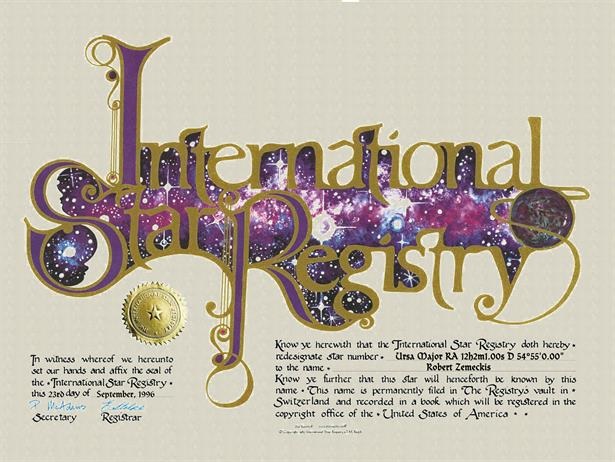Robert Zemeckis: A Stellar Career and a Star in Ursa Major
Updated: January 10, 2024 Author: International Star Registry

In a remarkable tribute to his cinematic genius, someone named a star after Robert Zemeckis through International Star Registry (ISR), immortalizing his name on September 23, 1996. This celestial body resides in the Ursa Major constellation, precisely located at RA 12h 2m 1.00s and D 54° 55′ 0.00″. To learn more about this remarkable filmmaker’s life and achievements, visit Robert Zemeckis’s Wikipedia page.
A Glimpse into Astronomy and Ursa Major
Before delving into Robert Zemeckis’s illustrious career, let’s explore the celestial wonder where his star resides. The Ursa Major constellation, also known as the “Great Bear,” is one of the most recognizable patterns in the night sky. It contains the famous Big Dipper asterism, a helpful guide for stargazers. Astronomers and enthusiasts often admire the Ursa Major for its distinct seven bright stars, each contributing to its unique charm.
The Gift of a Lifetime: International Star Registry
For those seeking extraordinary gift ideas, ISR offers a unique and celestial experience. Naming a star in someone’s honor is a thoughtful gesture suitable for birthdays, Christmas, anniversaries, or any special occasion. It’s a gift that transcends time and space, just like the films directed by Robert Zemeckis. To find out how much it costs to buy someone a star and explore various star-naming packages, visit www.starregistry.com.
Robert Zemeckis: A Cinematic Journey
Robert Lee Zemeckis, born on May 14, 1952, is a distinguished American filmmaker whose career spans several decades. He catapulted into the public eye as the director of the action-adventure romantic comedy “Romancing the Stone” in 1984. Zemeckis’s creative prowess truly shone through in the science-fiction comedy “Back to the Future” film trilogy (1985–1990) and the groundbreaking live-action/animated hybrid “Who Framed Roger Rabbit” (1988).
As Zemeckis continued to shape the film industry, he directed the satirical black comedy “Death Becomes Her” (1992) and ventured into more dramatic terrain with the iconic “Forrest Gump” (1994), for which he won the Academy Award for Best Director. “Forrest Gump” also clinched the Best Picture accolade, marking a pivotal moment in cinematic history. Throughout his career, Zemeckis displayed his versatility by directing films spanning a wide variety of genres, catering to both adults and families.
A Pioneer in Visual Effects
Robert Zemeckis is renowned for his pioneering work in visual effects. His filmography showcases his audacious exploration of state-of-the-art special effects. Notably, he seamlessly blended live-action and animation in “Who Framed Roger Rabbit” and introduced performance capture techniques in “The Polar Express” (2004), “Beowulf” (2007), “A Christmas Carol” (2009), and “Welcome to Marwen” (2018). Collaborating extensively with composer Alan Silvestri since “Romancing the Stone,” Zemeckis was lauded by critic David Thomson, who noted that “no other contemporary director has used special effects to more dramatic and narrative purpose.”
In conclusion, Robert Zemeckis’s cinematic journey is as mesmerizing as the stars in the night sky. His ability to push the boundaries of storytelling and visual effects has left an indelible mark on the film industry. Just as you can record a star name through International Star Registry, Zemeckis has etched his name in the annals of cinematic history. To learn more about star-naming packages and to purchase a stellar gift, visit www.starregistry.com.
References:
